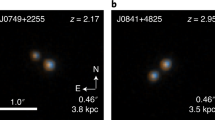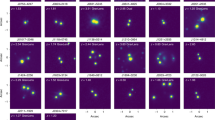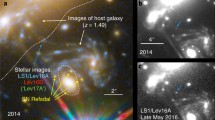Abstract
Clusters of galaxies can act as gravitational lenses1 which produce double quasars with splittings as large as 1–2 arc min. The potential well of the cluster must be deep enough on the scale of the image to focus the light, which means that the velocity dispersion within the cluster must be high and the core radius small. These requirements are reduced if there are two (or more) clusters along the line of sight. Paczynski and Gorski2 have modelled the triple image produced by two clusters without pursuing the probability of such an alignment in any detail. Here we predict the number of double quasar images in the sky that are produced by double clusters. The clustering of clusters3 and the occurrence of binary clusters4,5 enhances the probability of double clusters well above that expected from a purely random spatial distribution. Several double images are expected. Double clusters should be considered for apparent double quasar images such as Hazard 1146+111 B,C (refs 6,7) before cosmic strings8 or supermassive black holes9 are required. Although H1146+111B and C may not be due to a gravitational lens10,11, the discovery of a bona fide wide double quasar image will be important in the study of the evolution of the clustering of clusters.
Similar content being viewed by others
References
Naranan, R., Blandford, R. & Nityananda, R. Nature 310, 112–115 (1984).
Paczynski, B. & Gorski, K. Astrophys. J. 248, L101–L104 (1984).
Bahcall, N. A. & Soniera, R. M. Astrophys. J. 270, 20–38 (1983).
Ulmer, M. P. & Cruddace, R. G. Astrophys. J. Lett. 246, L99–L103 (1981).
Forman, W. et al. Astrophys. J. 243, L133–136 (1981).
Hazard, C., Arp, H. & Morton, D. C. Nature 282, 271 (1979).
Turner, E. et al. Nature 321, 142–144 (1986).
Gott, J. R. Nature 321, 420–421 (1986).
Paczynski, B. Nature 321, 419–420 (1986).
Nature 321, 377 (1986).
Shaver, P. A. & Christiani, S. Nature 321, 585–586 (1986).
Bahcall, N. A. Astrophys. J. 232, 689–698 (1979).
Bahcall, N. A. Astrophys. J. 247, 787–791 (1985).
Rivolo, A. R. Nature 317, 788–789 (1985).
Piccinotti, G. et al. Astrophys. J. 253, 485–503 (1982).
Quintana, H. & Melnick, J. Astrophys. J. 87, 972–978 (1982).
Jones, C. & Forman, W. Astrophys. J. 276, 38–55 (1984).
McGlynn, T. A. & Fabian, A. C. Mon. Not. R. astr. Soc. 208, 709–718 (1984).
Sunyaev, R. A. & Zel'dovich, Ya. B. Commts Astr. Space Sci. 4, 173–179 (1972).
Author information
Authors and Affiliations
Rights and permissions
About this article
Cite this article
Crawford, C., Fabian, A. & Rees, M. Double clusters and gravitational lenses. Nature 323, 514–515 (1986). https://doi.org/10.1038/323514a0
Received:
Accepted:
Issue Date:
DOI: https://doi.org/10.1038/323514a0
- Springer Nature Limited





